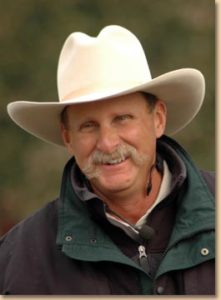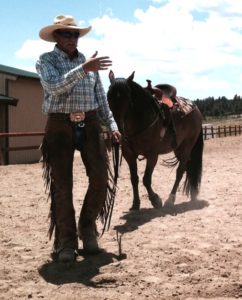Mark Rashid visited Durango for an evening lecture and three days of sold-out, one-on-one sessions recently. The author of several books and DVDs, Rashid travels internationally as a presenter and clinician.
 For the past several years, Rashid and Crissi McDonald, his wife of eight years, have incorporated Aikido, a Japanese martial art, into their work.
For the past several years, Rashid and Crissi McDonald, his wife of eight years, have incorporated Aikido, a Japanese martial art, into their work.
In martial arts as in horsemanship, there is potential for danger and violence, said Rashid, but the best approach is with softness. Softness (not to be mistaken with passivity) is internal softness, emotional softness, and physical softness.
Softness is successful “when my thought becomes your action,” said Rashid. “When we try to force things to happen, we never get them to happen.”
“Crissi and I try to find a way for the horses to be emotionally sound. You can get the feet, the teeth, and the body sound, but still put them under tremendous stress. We try to work horses towards a sense of peace and to ride in a clear and consistent way.”
Petra Sullwold, a Durango animal chiropractor, hosted Rashid and introduced him as an evening presenter. Sullwold worked  on Rashid’s horses and discussed her assessment:
on Rashid’s horses and discussed her assessment:
“I was amazed at how free and supple his horses felt,” said Sullwold, who has worked on a wide range of animal athletes, including Olympic-level horses. “It’s seldom I see freedom like that.”
Notes from the event:
Rashid on consistency: When horses don’t know when the other shoe is going to drop, we’ve got a problem. We want to ride in a clear and consistent way. Even a harsh cowboy will be appreciated (by the horse) for his consistency. It’s when you use spurs one day and not the other, or have soft hands one day and not the next, then those changes are problems.
- A Barn Sour horse is not thinking in the future. He’s thinking in the past: Where was I last comfortable?
 Horses have a spectrum of emotions, ranging from fear to curiosity. If you can turn the fear into curiosity, you’ve got them.
Horses have a spectrum of emotions, ranging from fear to curiosity. If you can turn the fear into curiosity, you’ve got them.
- Do not put value on the horse’s behavior. The horse cannot be a “bad” horse.
- Don’t direct any energy into anything you don’t want.
- Your primary cue is thought. First, use your inside to move the horse. The inside of you connects to the inside of the horse. Be aware of how your body functions. When you get tight, he’ll get tight. What does it take to go from a walk, to trot, to stop? Remember to breathe. Check out this article on Rider Balance
On herd dynamics, Rashid said horses in domestic herds are “completely backwards.” The most dominant are often the most insecure away from the herd, because the herd has defined them. Lower-ranked horses are often quite confident and comfortable away from the herd.
McDonald and Rashid met at one of his clinic years ago in Arizona. They married in 2008. Over the weekend, she weighed in on the couple’s collaboration:
“We do our best to live what we preach. We try to stay soft, to not get in each other’s way. We don’t always get it right, but each day is a chance to practice.”
McDonald is writing about rider fear and overcoming accidents, something with which she has experience. In 2014, she came off one of her horses and was unconscious for five minutes.
“I know so many women who berate themselves for being afraid,” said McDonald, who tasked herself with reading more about trauma recovery. “Ninety percent of working to get back on is done away from horses.” Read her blog here.
Understand the Cons of Comfort.
Thank you for stopping by the clinic. What a well written blog! You really hit the key points – Love it!